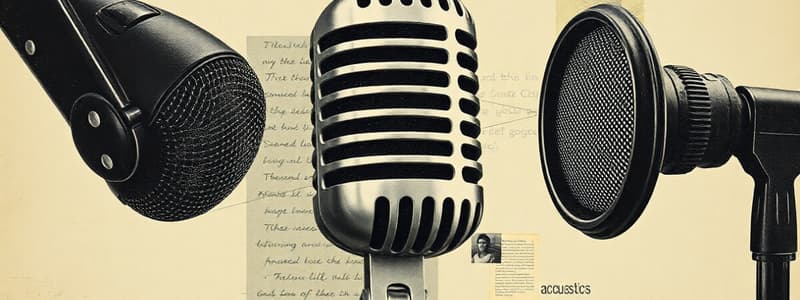Podcast
Questions and Answers
What primary function does a microphone perform?
What primary function does a microphone perform?
- Converts electrical energy into sound vibrations
- Amplifies sound vibrations for broadcasting
- Converts sound vibrations into electrical energy (correct)
- Records sound vibrations for future playback
Which type of microphone is generally known for its durability and ability to handle high sound pressure levels?
Which type of microphone is generally known for its durability and ability to handle high sound pressure levels?
- Lavalier microphone
- Condenser microphone
- Dynamic microphone (correct)
- Ribbon microphone
What polar pattern would be ideal for minimizing background noise during a musical performance?
What polar pattern would be ideal for minimizing background noise during a musical performance?
- Omnidirectional
- Figure-eight
- Cardioid (correct)
- Bidirectional
In what situation would a condenser microphone typically be preferred over a dynamic microphone?
In what situation would a condenser microphone typically be preferred over a dynamic microphone?
Which type of microphone is best suited for studio recording due to its sensitivity?
Which type of microphone is best suited for studio recording due to its sensitivity?
Which statement accurately describes a key difference between dynamic and condenser microphones?
Which statement accurately describes a key difference between dynamic and condenser microphones?
What is the primary characteristic of a bi-directional microphone?
What is the primary characteristic of a bi-directional microphone?
Which microphone type is least likely to be affected by wind when used in the field?
Which microphone type is least likely to be affected by wind when used in the field?
What is the primary function of polar patterns in microphones?
What is the primary function of polar patterns in microphones?
Which combination of microphone types is commonly used for recording large sound sources in a studio?
Which combination of microphone types is commonly used for recording large sound sources in a studio?
What type of energy does a microphone primarily convert?
What type of energy does a microphone primarily convert?
In which year was the condenser microphone invented at Bell Labs?
In which year was the condenser microphone invented at Bell Labs?
What does the directionality or polar pattern of a microphone indicate?
What does the directionality or polar pattern of a microphone indicate?
A unidirectional microphone is designed to pick up sound from which direction?
A unidirectional microphone is designed to pick up sound from which direction?
Which type of microphone is considered to be the most highly directional?
Which type of microphone is considered to be the most highly directional?
When selecting a microphone, which factor relates to its ability to handle different sound frequencies?
When selecting a microphone, which factor relates to its ability to handle different sound frequencies?
What is the main distinction between balanced and unbalanced microphones?
What is the main distinction between balanced and unbalanced microphones?
What is the ideal frequency range that a quality microphone can receive?
What is the ideal frequency range that a quality microphone can receive?
Flashcards are hidden until you start studying
Study Notes
Microphones
- Microphones convert sound vibrations into electrical energy, functioning as transducers.
- The diaphragm in a microphone moves in response to sound pressure, creating proportional voltage via transducers.
- Key types of microphones include dynamic and condenser, with distinct operating principles and applications.
- Sensitivity in microphones determines their ability to detect faint sounds, influencing choice for studio vs. field use.
Types of Microphones
- Dynamic Microphones: Utilize electromagnetic induction; robust and ideal for live environments.
- Condenser Microphones: Require power (phantom or battery) and are sensitive, suitable for studio recordings.
- Ribbon Microphones: Utilize a thin metal ribbon; highly sensitive and often used for vocals and instruments.
- Unidirectional Microphones: Capture sound primarily from one direction, reducing background noise.
- Omnidirectional Microphones: Capture sound from all directions, effective in capturing ambient sounds.
Polar Patterns
- Bi-directional Microphones: Sensitive to sound from two opposite directions, commonly used for duet performances.
- Directionality, or polar pattern, significantly affects microphone performance and suitability for specific applications.
Selection Factors
- Impedance: Affects microphone performance based on AC or DC circuits; lower impedance allows for longer cable runs.
- Frequency Response: An ideal microphone ranges from 20 Hz to 25,000 Hz, capturing both low and high frequencies.
- Pickup Pattern: Influences how sound is captured depending on microphone design, catering to specific recording needs.
- Balanced vs. Unbalanced: Balanced microphones (three wires) minimize noise for professional recordings, while unbalanced (two wires) are simpler and often used in casual settings.
Key Differences
- A microphone’s operation contrasts with that of a speaker, which converts electrical signals back into sound.
- Dynamic microphones are more rugged for live settings, whereas condenser microphones are favored in controlled environments for their sensitivity.
Practical Considerations
- Care must be taken to handle microphones properly to prevent damage.
- Understanding microphone specifications is crucial for selecting the right equipment for desired audio output.
General Knowledge
- Condenser microphones were invented at Bell Labs in 1917.
- Microphones have various applications across public speaking, music recording, and broadcasting.
Studying That Suits You
Use AI to generate personalized quizzes and flashcards to suit your learning preferences.





